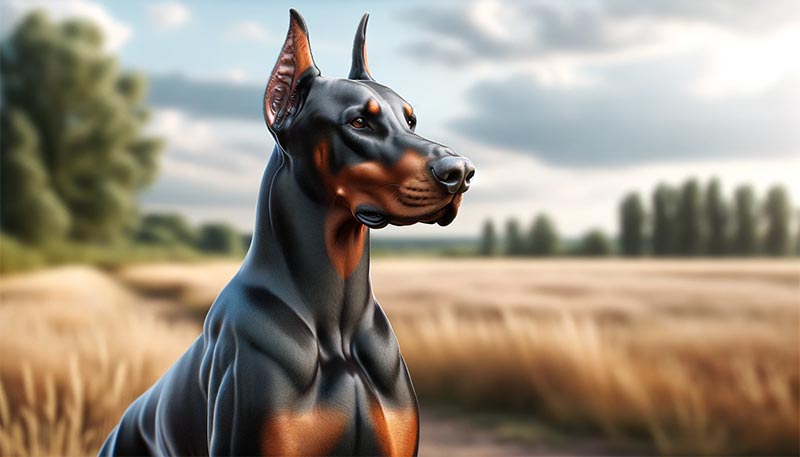The Doberman Pinscher, often simply called a Doberman, is a breed of domestic dog originally developed around 1890 by Karl Friedrich Louis Dobermann, a tax collector from Germany. The Doberman is known for its agility, loyalty, and strong guardian instincts, making it a popular breed for work in police and military roles, as well as a reliable family companion.
This blog post delves into the key characteristics of the Doberman Pinscher, providing insights into what makes this breed distinct and highly esteemed.
Physical Attributes
1. Size and Build: Dobermans are medium to large-sized dogs with a strong, muscular build. Males stand at about 26 to 28 inches at the shoulder, while females are slightly smaller, measuring around 24 to 26 inches.
2. Coat and Color: They have a short, smooth coat which is easy to maintain. Common colors include black, blue, red, and fawn, all typically with rust-colored markings on the face, chest, and legs.
3. Distinguished Appearance: One of the breed’s most notable features is its long, wedge-shaped head. Dobermans have dark, almond-shaped eyes that convey an alert and intelligent expression. Traditionally, their ears are cropped to stand erect, and their tails docked, though this practice is becoming less common.
Temperament
4. Loyalty and Protection: Dobermans are known for their loyalty to their families. They are naturally protective and can be excellent guard dogs when properly trained.
5. Intelligent and Trainable: This breed is highly intelligent and responsive to training. Dobermans excel in obedience, are quick to learn, and can be trained for a variety of roles, including search and rescue, and therapy work.
6. Energetic and Playful: Despite their serious appearance, Dobermans are energetic and playful, especially when young. They thrive in active environments and require regular exercise.
Health and Care
7. Exercise Needs: Dobermans need ample physical activity and mental stimulation. Daily exercise, such as long walks, runs, or play sessions, is essential for their well-being.
8. Health Concerns: Common health issues in the breed include heart conditions like dilated cardiomyopathy, hip dysplasia, and von Willebrand’s disease. Regular health check-ups and screening for genetic conditions are important.
9. Lifespan: The average lifespan of a Doberman Pinscher is around 10 to 13 years. A healthy diet, regular exercise, and proper medical care can contribute to a longer, healthier life.
Living with a Doberman Pinscher
10. Family Compatibility: Dobermans can be excellent family pets when properly trained and socialized. They are generally good with children and other pets if raised together.
11. Socialization and Training: Early socialization and consistent, positive training are crucial in nurturing a well-behaved and confident Doberman. They respond well to firm, fair, and loving guidance.
Conclusion
The Doberman Pinscher is a breed that combines elegance and strength with loyalty and intelligence. Their physical attributes, including a striking appearance and athletic build, are matched by a temperament that is protective yet affectionate.
With appropriate training, socialization, and care, a Doberman can be a wonderful addition to the family, serving as both a devoted companion and a capable protector.
Their versatility, combined with their noble demeanor, continues to make them a favored choice among dog enthusiasts around the world.
FAQs on Doberman Pinscher Characteristics
Q: How well do Doberman Pinschers adapt to apartment living?
A: Doberman Pinschers can adapt to apartment living if they receive adequate exercise and mental stimulation. Despite their size, they are relatively calm indoors but need space for daily activities to stay healthy and happy.
Q: Are Doberman Pinschers good with other dogs?
A: Dobermans can be good with other dogs, especially if they are socialized from a young age. However, they may exhibit dominant behavior, so introductions should be done carefully and gradually.
Q: Do Doberman Pinschers shed a lot?
A: Doberman Pinschers have a short coat and are moderate shedders. Regular brushing can help minimize shedding and keep their coat healthy.
Q: Can Doberman Pinschers handle cold weather?
A: Due to their short coat, Dobermans are not particularly suited for very cold climates. In colder weather, they may need a coat or sweater during outdoor activities.
Q: How vocal are Doberman Pinschers?
A: Dobermans are not excessively vocal, but they will bark to alert their owners of something unusual. They can be trained to minimize unnecessary barking.
Q: Are Doberman Pinschers prone to any specific behavioral issues?
A: If not properly trained and socialized, Dobermans may develop behavioral issues like excessive guarding, shyness, or aggression. Consistent training and early socialization can help prevent these problems.
Q: How often should a Doberman Pinscher be groomed?
A: Dobermans require minimal grooming. A weekly brushing is usually sufficient to keep their coat in good condition. Regular nail trimming, ear cleaning, and dental care are also important.
Q: Is the Doberman Pinscher suitable for novice dog owners?
A: Dobermans can be a challenge for novice dog owners due to their size, strength, and intelligence. They require an owner who can provide firm, consistent training and understand their protective instincts.
Q: Do Doberman Pinschers require a special diet?
A: Dobermans do not require a special diet, but they should be fed high-quality dog food appropriate for their age, size, and energy level. Proper nutrition is crucial for their health and well-being.



